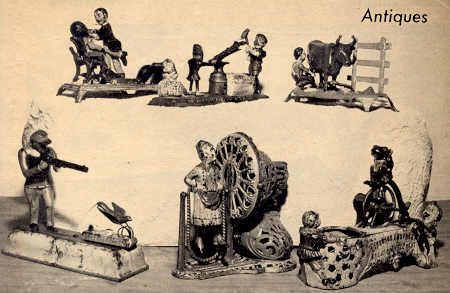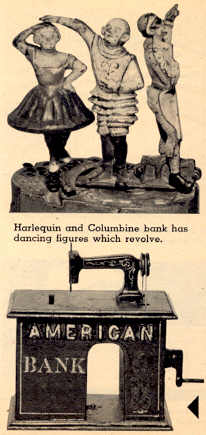|
THE PHILADELPHIA INQUIRER, October 23,
1955
Penny-Savers Of
Yesteryear
Designed for Humor and Thrift
BY ANN KILBORN COLE

SAY “I have a mechanical penny bank that really works,” to a collector and
he is likely to stand on his head or go into as odd contortions as some of
his own banks, because good mechanical banks are getting as rare as rocs’
eggs.
This hobby of collecting old penny banks has mushroomed over the last few
years until it has become a business in itself. A famous book about them,
written by the collector, John D. Meyer, is definitive and a “must” for all
collectors.
Old catalogs of the
manufacturers that sold the banks are antique items themselves and sell for
good prices. There are dealers who go in for banks almost exclusively, both
the mechanical ones that move and the less desirable “still” banks where
nothing happens but the rising glow of thrift when you deposit your penny in
some ingenious place.
I can readily understand
the fascination in gathering such working banks, especially when I come face
to face with a collection such as that owned by Mr. and Mrs. William Roup,
of Pottstown, who were kind enough to permit photographing some of their
best ones. They relate that Pennsylvania is the “bank” State in the
collector’s atlas. The stories back of the banks, their rarity and their value, is intensely
interesting but, to me, three facts make the overall story of mechanical
banks especially so:
The stories back of the banks, their rarity and their value, is intensely
interesting but, to me, three facts make the overall story of mechanical
banks especially so:
First, that all were
designed for pennies, and that 75 years ago the penny was so worthy of
saving that skilled artisans went to work to make the saving an easy and
enticing process.
Second, the ingenuity
that makes a battered old iron bank work perfectly with hairtrigger
precision today – though of course many have to be repaired and put into
working order.
And third, the humor of
them. Aside from the fact that many old-fashioned things seem funny to
modern eyes, these were designed to bring a laugh. They were the cartoons of
yesterday modeled in iron.
Thus in this collection
you will find the Dentist bank. All the banks have names, probably tagged in
the first catalogs, or maybe picked up over the years for identification. In
the Dentist bank we find a raucous pantomime of a scene in a dentist’s
office – always a good cartoon subject – where a penny deposited in the
dentist’s pocket will start him pulling a tooth and the patient to fall back
out of his chair while the penny disappears into safekeeping.
The Kicking Cow bank will
send the milker off his stool with the milk bucket in his face. A bank might
go further and lampoon a political situation, such as the labor and capital
routine in The Breadwinner bank where a penny is placed on a plank labeled
Monopoly and is sledge-hammered off into the rich man’s barrel.
Mechanical banks are not yet 100 years old. The oldest dates from about 1869
and they were made until the early 1900’s. The latest in the Roup collection
is called the Squeaking Doll’s Head, a 1921 version of an iron bank where a
baby’s head is breaking out of an eggshell. Here a penny inserted in the
bottom makes the doll-baby cry.
For rarity I was shown
one that is said to be the only one of its kind in existence. It is an iron
Presto bank. Other Presto banks have been found in tin. In this one a penny
is dropped into a box shaped something like a cash register, and when you
look into a peep-hole in the back you find you have a quarter instead! It’s
done with mirrors, naturally, but the motto on the front tells you, “We
offer aid to all who strive to make one penny twenty-five.”
Perhaps the most valuable
bank in this collection is the famous Harlequin and Columbine, the goal of
many a collector. Here three dancing figures revolve around each other. The
rarity, rather than ingenuity, makes it tops in price. Another valuable bank
of which only three are known to exist is the Sewing Machine bank where the
needleshaft works up and down when the penny goes in. Still another, the
Fowler, is a triumph in ingenuity. When the penny is inserted the hunter
takes aim, fires a real cap in his gun, the bird flies into the air
(released by a spring) and the hunter swings to bring it in line before it
falls dead at the end of its string.
In the photo you will also see the Skipping Rope bank where an iron girl in
Victorian costume nimbly skips rope, and the professor Pug-Frog bank, a
nursery rhyme affair with Mother Goose looking on.
There are many other fine banks in
the Roup collection, including the Girl in the Victorian Chair and a
revolving Ferris Wheel bank which is at least a foot high.
(Web Note:
Many thanks to Mrs. Edward Early, daughter of William and Lena Roup, for
providing a copy of the above article.) |


